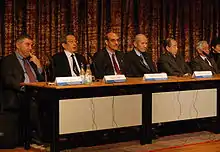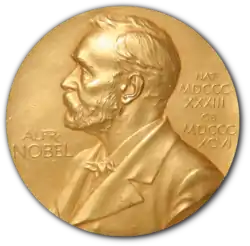Osamu Shimomura
Osamu Shimomura (下村 脩, Shimomura Osamu, August 27, 1928 – October 19, 2018[1]) was a Japanese organic chemist and marine biologist, and Professor Emeritus at Marine Biological Laboratory (MBL) in Woods Hole, Massachusetts and Boston University School of Medicine. He was awarded the Nobel Prize in Chemistry in 2008 for the discovery and development of green fluorescent protein (GFP) with two American scientists: Martin Chalfie of Columbia University and Roger Tsien of the University of California-San Diego.[2]
下村 脩 Shimomura Osamu | |
|---|---|
 Shimomura in 2008 | |
| Born | August 27, 1928 |
| Died | October 19, 2018 (aged 90) |
| Nationality | Japan |
| Alma mater | Nagasaki University Nagoya University |
| Awards | Asahi Prize (2006) Nobel Prize in Chemistry (2008) Golden Goose Award (2012) |
| Scientific career | |
| Institutions | Princeton University Boston University School of Medicine Marine Biological Laboratory |
Biography

Born in Fukuchiyama, Kyoto in 1928, Shimomura was brought up in Manchukuo (Manchuria, China) and Osaka, Japan while his father served as an officer in the Imperial Japanese Army. Later, his family moved to Isahaya, Nagasaki,[3] 25 km from the epicenter of the August 1945 atomic bombing of the city. He recalled hearing, as a 16-year-old boy, the bomber plane Bockscar before the atom bomb exploded.[4] The explosion flash blinded Shimomura for about thirty seconds, and he was later drenched by the "black rain" bomb fallout.[5] He overcame great odds in the following 11 years to earn an education and achieve academic success.[3]
Shimomura's education opportunities were starkly limited in devastated, post-war Japan. Although he later recalled having no interest in the subject,[4] he enrolled in the College of Pharmaceutical Sciences of Nagasaki Medical College (now Nagasaki University School of Pharmaceutical Sciences).[6] The Medical College campus had been entirely destroyed by the atomic bomb blast, forcing the pharmacy school to relocate to a temporary campus near Shimomura's home. This proximity was the fortuitous reason he embarked upon the studies and career which would ultimately lead to unanticipated rewards.[4] Shimomura was awarded a BS degree in pharmacy in 1951, and he stayed on as a lab assistant through 1955.[4]
Shimomura's mentor at Nagasaki helped him find employment as an assistant to Professor Yoshimasa Hirata at Nagoya University in 1956.[6] While working for Professor Hirata, he received a MS degree in organic chemistry in 1958 and, before leaving Japan for an appointment at Princeton University, a Ph.D. in organic chemistry in 1960 at Nagoya University.[7][8] At Nagoya, Hirata assigned Shimomura the challenging task of determining what made the crushed remains of a type of crustacean (Jp. umi-hotaru, lit. "sea-firefly", Vargula hilgendorfii) glow when moistened with water. This assignment led Shimomura to the successful identification of the protein causing the phenomenon, and he published the preliminary findings in the Bulletin of the Chemical Society of Japan in a paper titled "Crystalline Cypridina luciferin." The article caught the attention of Professor Frank Johnson at Princeton University, and Johnson successfully recruited Shimomura to work with him in 1960.
Study
Shimomura worked in the Department of Biology at Princeton for Professor Johnson to study the bioluminescent jellyfish Aequorea victoria, which they collected during many summers at the Friday Harbor Laboratories of the University of Washington.[9] In 1962, their work culminated in the discovery of the proteins aequorin and green fluorescent protein (GFP) in A. victoria;[10] for this work, he was awarded a third of the Nobel Prize in Chemistry in 2008.
Family
His wife, Akemi, whom Shimomura met at Nagasaki University, is also an organic chemist and was a partner in his research activities. Their son, Tsutomu Shimomura, is a computer security expert who was involved in the arrest of Kevin Mitnick. Their daughter, Sachi Shimomura, is director of Undergraduate Studies for the English Department at Virginia Commonwealth University and the author of Odd Bodies and Visible Ends in Medieval Literature.
Recognition
- 2004 – Pearse Prize, Royal Microscopical Society[11]
- 2005 – Emile Chamot Award[12]
- 2006 – Asahi Prize
- 2008 – Nobel Prize in Chemistry
- 2008 – Order of Culture[13]
- 2008 – Person of Cultural Merit
- 2012 – Golden Goose Award[14]
- 2013 – Member of the United States National Academy of Sciences
- 2018 – Junior third rank (posthumous)
Selected publications
- Bioluminescence: Chemical Principles and Methods (Revised Edition) (WSPC 2012) ISBN 978-981-4366-08-3.[15]
『クラゲに学ぶ : ノーベル賞への道』(長崎文献社 2010年 ISBN 978-4-88851-157-5) * 安永峻五、下村脩、『無機クロマトグラフィーに関する研究-6-』 Journal of the Pharmaceutical Society of Japan 74(7), 778-780, 1954–07 * 『口紙電気泳動に関する研究 (第3報) 難溶性塩および錯イオンの生成時における濃度-泳動度曲線について』 日本化學雜誌 Vol.76 (1955) No.9 P.973-977, doi:10.1246/nikkashi1948.76.973 * 『アニリン誘導体およびフェエノール誘導体のロ紙電気泳動について』 日本化學雜誌 Vol.76 (1955) No.3 P.277-281, doi:10.1246/nikkashi1948.76.277 * 平田義正、江口昇次、下村脩、『海ホタルルシフェリンの構造』 天然有機化合物討論会講演要旨集 (3), 83-93, 1959-10-17 * 『海ホタルルシフェリンの構造(第2~3報) (第2報)海ホタルルシフェリンの性質および分子式について』 日本化學雜誌 Vol.81 (1960) No.1 P.179-182, doi:10.1246/nikkashi1948.81.179 * 『海ホタルルシフェリンの構造(第2~3報) (第3報)海ホタルルシフェリンおよびヒドロルシフェリンの推定構造』 日本化學雜誌 Vol.81 (1960) No.1 P.182-185, doi:10.1246/nikkashi1948.81.182 * 『緑色蛍光たんぱく質GFPは天の恵みか?』 Acta anatomica Nipponica 85(3), 99-106, 2010-09-01
See also
References
- Chang, Kenneth (24 October 2018). "Osamu Shimomura, 90, Dies; Won Nobel for Finding a Glowing Protein". The New York Times.
- "The Nobel Prize in Chemistry 2008". The Official Web Site of the Nobel Foundation. Retrieved 2008-11-04.
- "Aglow in the Dark: The Revolutionary Science of Biofluorescence". Harvard University Press. Retrieved 2017-11-28.
- Nobelprize.org: Nobel laureate lecture. December 8, 2008.
- "Osamu Shimomura The Nobel Prize in Chemistry 2008 Interview". The Official Web Site of the Nobel Foundation. Retrieved 2009-01-12.
- "Woods Hole cell biologist wins Nobel Prize". boston.com. Retrieved 2017-11-28.
- "Former Associate Professor Osamu Shimomura Wins the Nobel Prize in Chemistry". Nagoya university. Retrieved 2008-12-05.
- "下村脩先生が2008年ノーベル化学賞をご受賞". Nagoya University. Archived from the original on 2008-12-19. Retrieved 2008-12-05.
- "Nobel goes to former Princeton researcher for discovery made here". princeton.edu. Retrieved 2017-11-28.
- "GFP History". Marc Zimmer. Retrieved 2008-12-09.
- "About the Pearse Prize". Royal Microscopical Society. Retrieved 2016-06-10.
- "Emile Chamot Award Recipient". State Microscopical Society of Illinois. Archived from the original on 2008-12-10. Retrieved 2008-12-09.
- "Donald Keene, 7 others win Order of Culture," Yomiuri Shimbun. October 29, 2008.
- "Green Fluorescent Protein". The Golden Goose Award. Retrieved 2015-05-27.
- "Bioluminescence: Chemical Principles and Methods". World Scientific. Archived from the original on 2012-07-10. Retrieved 2017-11-28.
Sources
- Osamu Shimomura on Nobelprize.org
 including the Nobel lecture Discovery of Green Fluorescent Protein, GFP
including the Nobel lecture Discovery of Green Fluorescent Protein, GFP
